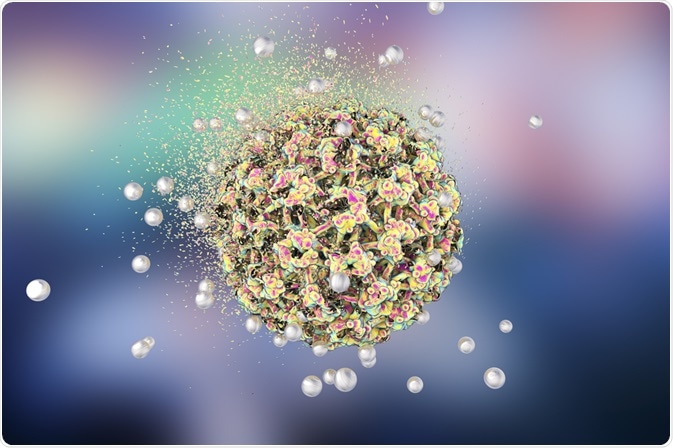Targeted drug delivery methods ensure that drugs are delivered to the site of interested, whilst minimizing the damage to the surrounding tissue. They also allow a lower dose of the drug to be used, further preventing interaction with off-target sites, and improving patient quality of life.
 Image Credit: Kateryna Kon / Shutterstock
Image Credit: Kateryna Kon / Shutterstock
Nanoparticles get their name from their nanometer (nm) size (a billionth of a meter). Nanoparticles range from 1 to 100 nm, allowing them to be easily taken up by cells. Thus, their use as carriers of drugs (nanocarriers) has increased significantly in the past decade.
In order for nanoparticles to function as a drug delivery system, the drug has to be attached to the nanoparticle first.
This step is crucial, and there are several ways of achieving this: the drug can be adsorbed or covalently attached to the nanoparticle surface or the drugs can be encapsulated in the nanoparticles.
There are specific advantages to each method. During covalent attachment, the molecules are attached to the nanoparticles using recognition ligands. The use of covalent linkage gives the ability to control the number of the therapeutic compound attached to the nanoparticle.
NANOATHERO video SUBTITLED ENGLISH
Delivery of nanocarriers to the target site
The delivery of drugs to the target site can be achieved via active or passive methods. Active methods involve modifying the physical conditions, such as temperature, pH and magnetism to get the nanoparticles to specific regions.
Passive methods involve modifying the vascular permeability and retention (EPR) parameters. For example, smaller particles preferentially localize in tumors due to the EPR of tumors.
The nanocarriers should not accumulate in the cell for too long, as they could affect innate biological processes. However, smaller particles may be more reactive due to their increased surface area, and thus potentially more toxic.
Types of nanocarriers
Liposome
Liposomes were the first type of nanocarriers, and are around 80−300 nm in size. They are spherical and consist of phospholipids and steroids. They can be prepared spontaneously by dispersing lipids in aqueous media.
A drug can be encapsulated inside the liposome, and it can be subsequently released from the drug by changing parameters such as pH, osmotic gradient, and surrounding environment.
Different surface modifications also improve the half-life of the liposomes. For example, addition of polyethylene glycol (PEG) increases the half-life of liposomes by preventing recognition by phagosomes.
Similarly, polyethylene glycol-phosphatidylethanolamine (PEG-PE) conjugates have also been added. PEG-PE conjugates are non-toxic and can be used to specifically target the nanocarrier to the mitochondria.
Nanoparticles based on solid lipids
Lipid based nanoparticles include solid lipid nanoparticles (SLN), nanostructured lipid carriers (NLC), and lipid drug conjugates (LDC).
The SLN are based on solid lipids and provide good physical stability and tolerability. NLC and LDC are combinations of solid and liquid lipids with increased load capacity and reduced drug expulsion properties.
Polymeric nanoparticles
They are derived from synthetic polymers and range from 10−100 nm. They can be further sub-divided in to biodegradable and non-biodegradable. Drugs can be conjugated on the surface of these nanocarriers by polymerization and they can be released by desorption or diffusion in the target tissue.
Bbiodegradable nanocarriers can undergo hydrolysis inside the body to give lactic and glycolic acid. They are also stable in blood, non-toxic, and non-thrombogenic.
Dendrimer nanocarriers
Dendrimer nanocarriers consist of following features: core, dendrons (dendrimers), and surface active groups. The dendrons are attached to the core and properties of the nanocarriers are determined by the type of surface active groups.
Several ligands can attach to the surface of dendrimers, such as folic acid, antibodies, peptides, PEG, or antimicrobial agents. These additions modify the physical and chemical properties of dendrimers.
Silica materials
Silica materials used as nanocarriers include xerogels and mesoporous silica nanoparticles. MCM-41 is a well-known silica nanomaterial. The drug loading in these materials occurs via adsorption and the drug release is governed by diffusion.
However, recent studies have also shown certain hazardous effects where silica nanoparticles trigger oxidative stress and the production of reactive oxygen species in cells. Thus, there is a need for further investigation into the effects of these silica nanocarriers.
Carbon nanomaterials
Carbon nanomaterials include nanotubes and nanohorns. They can be formed of single nanotubes rolled in to a sheet or multiple nanotubes arranged concentrically.
Surface modifications can be added to these to improve their biocompatibility. They have high mechanical strength and thus have also been used to as a support for other nanocarriers.
Drugs can be added to carbon nanotubes by encapsulation, adsorption, or attaching active agents to the nanotubes. The drug can be released by physical or chemical modifications.
Further Reading